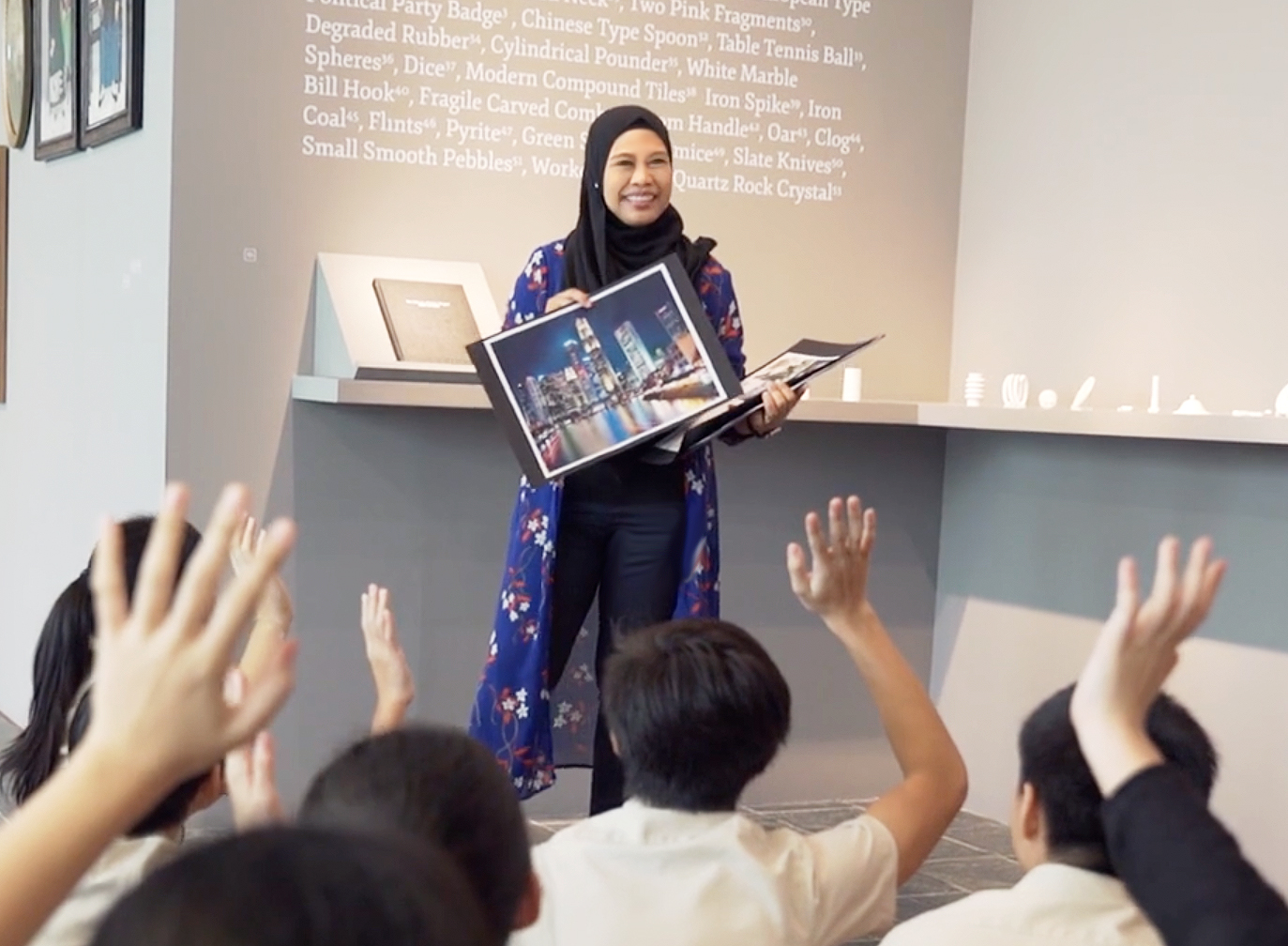Ira Wati Binte Sukaimi, Mayflower Secondary, President’s Award for Teachers 2020 Recipient
“They look like armed soldiers,” a student ventured.
“That looks like the sedia position in the parade ground,” added a student from a uniformed group.
“Don’t they feel hot, covered like that?” asked another.
What was going on? This was a photography class and the Mayflower Secondary 1 students were role-playing the subjects of the photograph “Grasscutters”, by local artist Jing Quek. It’s part of a series, titled “Singapore Idols” that captures the lives and labour of Singapore’s diverse communities.
For Art teacher Ira Wati Binte Sukaimi, it’s important for students to understand the ‘whys’ of making Art rather than simply focusing on the ‘how’.
“Of course, I teach technicalities of photo-taking, like depth of field, focal point, symmetrical vs asymmetrical viewpoints, etc., but there’s more than technical competency,” she said. “I want them to know why they are learning this and to use it to gather a deeper understanding of more enduring issues. Techniques are just tools.”
So as her students mimicked the positions of the grasscutters as shown in the photograph, to get into their shoes, the discussion morphed from the superficial – “they look like armed soldiers” – to the more reflective – “they need to be fully covered to protect them from splinters and flying rocks”.
Discussions like this are an opportunity for students to look beyond stereotypes and misconceptions and have more empathy for different communities of people, says Ira Wati. For instance, the students came to understand that grasscutters were mainly foreign workers. They took pride in their work even though Singapore is not their home.
Following this lesson, they shot photographs of micro-communities within the school – teachers, canteen vendors or security officers.
“I make sure students learn more than techniques,” explained Ira Wati. “I want them to express themselves, take an interest in social issues and break down stereotypes – all of which are integral to character building.”
More than meets the eye
In another exercise in self-expression, for a lesson on ceramics, Ira Wati got students to create gargoyles that would be placed in the school building to protect the school community. Students could decide what they needed protection from.
Some cited exam stress and bullies. Some feared gunmen and earthquakes. Others wanted to eliminate racism.
Through listening to each other’s’ fears and discussing them openly, they learnt empathy, tolerance and a greater appreciation for peer experience – beyond practical skills in modelling clay.
“Art is a vehicle to teach students about big ideas and enduring issues. This is greater than shading or painting. These are what will equip them with skills, attitudes and values that they can continue to harness even after they are done with school,” said Ira Wati.
Motivating students with Art
Mdm Ira works with students across levels with different learning abilities. She takes a special interest in finding ways to motivate low-progress learners and help them break out of negative misconceptions about identity and self-worth.
“If students cannot clear their minds…[of] issues such as domestic tensions, or financial difficulties, or a family illness… there is no way for them to listen to us talk about photo composition or any such,” she said.
Through her classes, such as the one on grasscutters, the gargoyles or when talking about artwork during museum visits, she creates opportunities to hear from her students about their concerns. “Artworks show the shared human experience,” she said.
She also organises visits to artists’ studios where students get to see more of the artists’ lives for inspiration.
There are other lessons along the way. “Art-making may be a messy process when you work with clay, for example, but it doesn’t mean artists leave their studios in a mess. Students get to see work ethics in action.
“It’s also important for students to see artworks in progress. They witness how artists have to persevere… Behind every polished piece of art is an untold number of hours that artists have to work at a stretch,” she said.
She draws parallels to her students’ own lives: “They may be encountering a lot of challenges now – exam stress, relationship problems – but that is the… same process of becoming a polished artwork. So I draw that analogy for them.”
Showtime!
For Ira Wati, it’s about the process rather than just the end result. Apart from organising the Graduation Show every year to showcase artworks of graduates, she initiated the “Works in Progress” exhibition for her Secondary 3 students. This is just what it says – students can show works that are in progress. The purpose is to document their journey in Art and personal growth, says Ira Wati, and also to drive home the message that it’s ok to not be perfect. “You have to be responsible for the choices you make,” she said. Students have autonomy for the running of the show. They curate the works, decide on the guest list, right down to hosting the guests.
She is game for spontaneity and for “serious-play”, as she calls it as well. Take the impromptu catwalk show that she pulled together with her Secondary 1 class.
“It was to be just a class activity to conclude the module on sculpture. Students were to use inspiration from nature to create hats. The idea was to understand animal habitats and how the ecosystem operates.”
“Upon seeing their beautiful works, the idea of a catwalk show came to mind. The boys were not too thrilled initially, but they were sporting. The students paraded down the school corridor in pairs to showcase their headpieces,” she recalled.
“When students present their works, you can feel their energy and excitement,” Ira Wati said. “Students also demonstrate a more inquisitive disposition because they can find meaning in the learning tasks that they need to execute.”
As Ira Wati knows, it’s about the ‘why’





.jpg)
